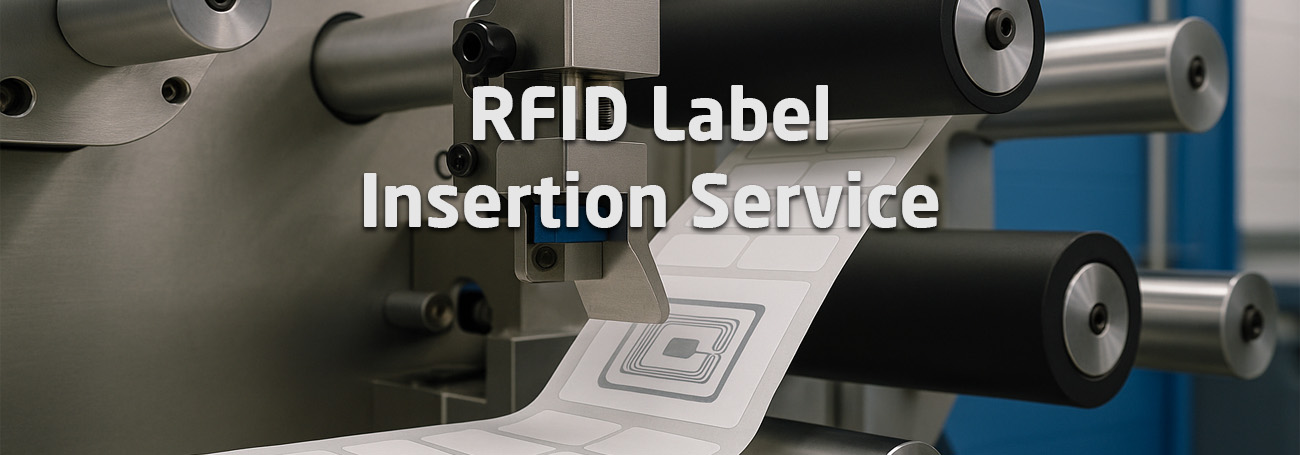GoToTags Now Offers NFC and UHF RFID Label Insertion Services
GoToTags now offers RFID label insertion services that insert NFC or UHF RFID inlays into existing printed labels. This new RFID label converter service enables companies to add smart label functionality without having to redesign their labels or change their print suppliers. It provides a practical way for businesses to adopt RFID technology while maintaining their existing branding, packaging and supply chain workflows.
RFID Label Insertion Overview
What it does: Embeds NFC or UHF RFID inlays into existing printed labels.
Why it matters: Maintains brand consistency and existing supply chain relationships.
Compliance: Maintains compatibility with standards such as GS1 Digital Link and supports requirements like the Walmart RFID mandate.
Production: Specialized insertion equipment and trained operators ensure high quality and precise label conversion. Minimum order quantities (MOQs) and feasibility checks apply.
What is an RFID Label
An RFID label is a printed label, either prime (consumer-grade) or industrial grade, that includes an embedded NFC inlay or UHF RFID inlay. These inlays give labels digital capabilities for applications such as consumer engagement, inventory tracking, authentication and asset management.
RFID labels are often used alongside printed barcodes such as QR Codes, DataMatrix, or Universal Product Codes (UPCs). These are frequently serialized or correlated to digital IDs using the GS1 Digital Link standard, which connects physical products to online information.
- NFC labels work with smartphones and industrial readers, making them useful for consumer interaction.
- UHF RFID labels use specialized readers that can scan large volumes of tags quickly, making them ideal for inventory and logistics systems.
What is RFID Label Insertion
RFID label insertion transforms a standard label into an RFID enabled one by placing an RFID inlay beneath its surface. A specialized machine lifts each pre-printed label, positions an RFID inlay underneath, and then reapplies the label. This process maintains the look and feel of the original label while adding digital functionality.
Because RFID insertion requires precision, only commercial printing operations equipped with specialized machinery and trained technicians can perform it effectively. The result is a high-quality label that maintains its original appearance but now includes the power of RFID technology.
Why Insert RFID Labels
Companies often have existing approved, tested and branded labels that cannot be easily altered. Most commercial printers are not equipped to produce RFID labels, which creates challenges for companies trying to meet new RFID requirements.
Switching commercial printers can introduce delays, additional costs, and unnecessary risk due to the need for new designs, testing, and approvals. The Walmart RFID mandate has made this problem more urgent, requiring many suppliers to find a quick and reliable path to compliance.
Companies can insert RFID inlays into their existing labels to maintain design while meeting technical and compliance standards. This method helps companies save time, minimize cost, and follow mandated RFID standards.
Examples of RFID Label Insertion Use Cases
The following examples show how RFID label insertion supports different tag technologies and use cases.
NFC Tags in Wine Labels for Anti-Counterfeiting and Consumer Engagement
Counterfeit products continue to be a serious issue in the wine industry, creating both safety and financial risks. Traditionally, verifying authenticity requires chemical analysis or forensic testing, which is expensive and slow.
With NFC label insertion, wineries can embed a secure NFC inlay into their existing labels and use software systems to enable cryptographic authentication. Consumers can simply tap the bottle with their smartphone to confirm authenticity and interact with brand content.
Because wine labels are often the result of long design and approval cycles, wineries prefer not to change their commercial printers. NFC label insertion lets them retain their existing designs while adding digital security and consumer engagement. For added protection, wineries can choose high-security chips such as the NXP NTAG 424 DNA.
UHF RFID Inlays on Prime Labels for Walmart RFID Mandate
Walmart now requires most general merchandise suppliers in the U.S. to implement RFID technology into their labels by 2025. These labels must follow the technical standards defined in the Walmart RFID Playbook and be certified through the Auburn University Label Excellence Center (ALEC) program.
Many suppliers use labels that serve multiple functions, such as branding, barcode identification, and now RFID tracking. Reprinting or redesigning these labels can delay compliance and increase costs. RFID label insertion allows suppliers to modify their current labels without starting from scratch.
Products like large plastic bins or retail items with limited packaging space benefit the most from this approach. By inserting RFID inlays, suppliers can meet Walmart’s requirements while maintaining the label’s appearance and ensuring production efficiency.
Conclusion: Bringing RFID to Your Existing Labels
RFID label insertion offers a cost-effective and low-disruption way to add RFID to existing labels. It enables companies to move forward with RFID adoption while continuing to use their trusted commercial label printers.
Determining whether insertion is the right solution depends on each project’s requirements, production volume, and label compatibility. Minimum quantities and technical evaluations apply to ensure the process aligns with label specifications.
As a leader in NFC, UHF RFID, and barcode label technologies, GoToTags has helped thousands of businesses successfully implement RFID technology. Contact GoToTags to learn more or request a quote for RFID label insertion services.
